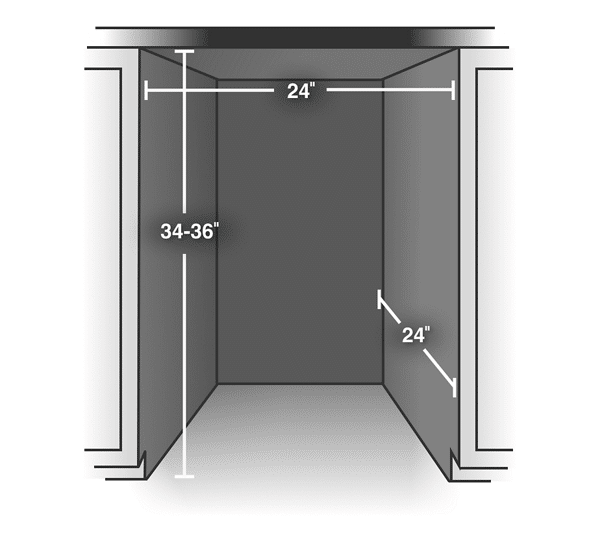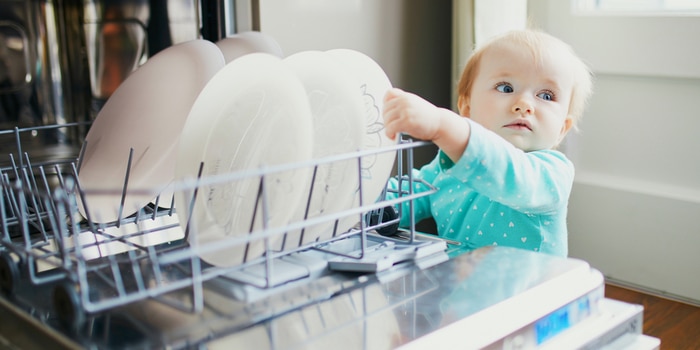We've independently reviewed this article to make sure it's as accurate as we can make it.
To find out more about our article creation and review process, check out our editorial guidelines.
Are you having a hard time trying to decide what dishwasher size you should get?
Picking the right appliance can be challenging, as there are many different dishwasher sizes out there, so it’s no surprise that thousands of people get confused daily.
The good news is that you’ve come to the right place for answers.
When choosing the right dishwasher size for your home, you need to focus on different factors, such as the size of your family, noise level, cleaning features, energy and water consumption, offered cycles, and style.
Read on to buy the right dishwasher!
Why trust us? This article was written by Craig Anderson and James Blackford.
Craig has helped thousands of other homeowners repair their appliances since 2016.
James is one of our resident appliance experts, with over 16 years of experience. He currently works as a Master Technician for SquareTrade, and runs his own appliance repair business.
Is There a Standard Dishwasher Size?
Most dishwashers have a standard size of 24 inches (0.61 m) deep, 34 inches (0.89 m) high, and 24 inches (0.61 m) wide, and a capacity of 12 to 14 standard place settings.

The standard dishwasher size is perfect for a typical family of 6 to 8 people. And luckily, most household cabinet openings are designed to fit it.
However, it’s critical to remember that some handles may affect the dishwasher’s depth; that’s why measuring the space and checking the measurements is an important step. To help make the whole dishwasher size concept clearer, here’s a small table for a visual aid:
| Dishwasher Size | Family Members | Dishwasher Capacity |
| Compact (18in wide, 34in tall, and 24in deep) | 1-2 | 6-9 place settings |
| Standard (24in wide, 34in tall, and 24 in deep) | 3-4 | 9-12 place settings |
| Oversized (30-40in wide, 24in tall, 24in deep) | 5+ | 12+ place settings |
Different Dishwasher Types
Similar to other appliances, there are different dishwasher sizes and many form factors that can cover different needs.
Before we dive into how you can measure your dishwasher, I recommend you check out the table below, explaining each dishwasher type’s main advantages and disadvantages. If you’d like to know more, our dishwasher buyer’s guide has all the information you need.
| Dishwasher Type | Pros | Cons |
| Built-In | -Quiet -Discrete-looking -Cheaper than other options | -Can’t be moved after being installed |
| Portable | -Easy to move around -Easy to connect to any water line -Cheap options | -Noisy -Might not be as large as other dishwasher types |
| Countertop | -Compact and convenient -Affordable -Can be hooked up and stored almost anywhere -Great dishwasher for small spaces | -Small, not great for large families |
| Drawer | -Quiet and versatile -Typically, these dishwashers need less detergent than other models | -Smaller, not ideal for larger families -Expensive |
| Integrated | -Easily concealed behind kitchen cabinetry -Multiple features | -Expensive -Typically require professional installation |
How to Measure a Dishwasher: 3 Simple Steps
Sometimes it’s crucial to know the measurements of your dishwasher, especially if you want to create space in your kitchen for the unit. To take measurements, you’ll only need a measuring tape and, of course, this guide. So let’s begin!
#1 Measure the Width
With your measuring tape, measure from left to right. Make sure it’s inside edge to inside edge of the cabinet opening.
Make sure to measure the top and bottom of the cabinet. Then, write down your measurements.
If you are installing your dishwasher near a wall, allow a 2-inch breathing gap between the wall and the dishwasher door. In my experience, giving your dishwasher enough breathing room will prevent heat build-up and ensure the appliance’s effectiveness.
#2 Measure Depth
Measure from the back to the front. Make sure to leave enough room in front of the dishwasher to account for loading and moving around the open dishwasher door and the counters or island.
Please write down the measurements so that you can remember them later.
#3 Measure the Height
Measure the floor of the opening and the lowest point of the countertop. Most dishwashers dimensions require a 36-inch-tall opening to fit perfectly in the space.
However, additional layers in the kitchen flooring may affect the installation process.
The Ideal Dishwasher Sizes and Features for Different Groups of Families
To choose the right dishwasher size for your home, you’ll need to consider how many people there are in your family.
Here are some tips to estimate your needs:
#1 Singles
If you’re single or live alone, you don’t need to dent your wallet to get the right dishwasher size.
Generally, the main difference between large and smaller washers is the price and place settings. If you live alone, noise may be a non-issue unless you live in a small house or your kitchen is next to the bedroom.
You will also benefit from durability as you will only use your washer once a day. However, I’d recommend fully loading your unit and maximizing its functionality to avoid water and energy wastage.
If you’re only washing one cup, why not just handwash it instead of running a whole cycle? You’ll save a lot of money and take care of the environment.
#2 Small Families with Children
Small families of two or three members typically have the same dishwasher needs as singles. However, if guests visit often, getting the average dishwasher is wiser to avoid overwhelming your unit.
Bear in mind that if you have children, you must be more particular when choosing dishwasher sizes, as your needs may differ slightly from those of adult families.
Apart from constant washing, you must find a childproof or child-lock unit for safety while the dishwasher is running. I recommend dishwashers with inconspicuous, complex handles for families with small children.

Low noise levels and an easy-to-clean finish are also factors to consider when looking at dishwasher sizes, especially if you have a baby.
#3 Dishwashers for Adult Families
By adult families, I mean parents living with adult sons and daughters who are in college or have just completed university.
Premium dishwashers with a unique finish can be a perfect fit for adult families.

#4 Dishwashers for Large Families
Larger families have all the reasons to get a quality dishwasher that can clean any amount of soil.
Ideally, if you have a large family, you’ll want to buy one of the bigger dishwasher sizes. You should look for a dishwasher with enough settings, different cycles, and different water levels to save time, energy, and money.
Larger units are built for performance and usually have premium features like WI-FI for efficient cleaning. A quiet model is a great option, as you will run the machine more than twice daily.
There are other excellent dishwasher features to consider, such as stacking and racking. Three extended loading options are also perfect for larger families, as dishes are easier to load and organize. These features also include removable shelves, racks, and tines to accommodate different utensils.
What Features Should the Ideal Dishwasher Have?
While having a budget in mind is essential, the dishwasher price range doesn’t really matter when picking the right-sized appliance. Most options have the same interchangeable features. So, I suggest focusing on the features and dishwasher dimensions to satisfy you and your family before checking the prices.
With that in mind, let’s look at those critical features.
#1 Size and Capacity
Dishwasher sizes and capacities should be your main focus if you want to save money, energy, and effort. Size is linked to your daily needs and the space in your kitchen.
Smaller units measuring 18 inches (ca. 46 cm) wide can find space even in smaller kitchens and function just like bigger dishwashers. The only difference is that they take up less space and quantity.
So, please don’t go for a bigger unit because you think it cleans better. You’ll only be wasting energy and water.
#2 Noise Level
We all know how important the noise level can be, especially if you’re like me and like a quiet home!
Like laundry machines, dishwashers have their own share of noise to add to your home, and the last thing you want is a migraine-inducing machine.
Check the dishwasher sound rating and choose a whisper-quiet model. But if reviewing sound ratings isn’t possible, try to stay somewhere between quiet operation and the right dishwasher dimensions.
Think about the location of your dishwasher and determine whether you will be able to watch Netflix undisturbed or have a conversation in the room or the next room when the machine is running.
#3 Cleaning Power
Unfortunately, you cannot predict cleaning performance based on brand, price, or smart features. But the good news is that you can find a dishwasher with quality cleaning power without breaking the bank.
A good dishwasher should clean any baking utensils well; it doesn’t matter how stuck, messy, or thick the soil is.
However, if you prefer helping your dishwasher by scraping or rinsing your dishes before loading them in, any model should be able to clean them spotlessly with little effort.
#4 Energy and Water Consumption
A good dishwasher should help you save energy, water, and time.
Most dishwasher sizes will have a star rating label certified by the U.S. Department of Energy (DOE). The more stars, the better the energy efficiency you’ll get.
Generally, modern dishwashers use less power and water than older plain white, noisy models.
#5 Speed and Cycles
Most dishwashers offer an “Auto-Sense,” “Auto-Wash,” or “Smart Wash” feature that monitors the soil level and adjusts the wash time accordingly. “Auto-Wash” can reduce wash time by half, saving you time and energy.
However, please note that the “Auto-Wash” feature might not be useful in areas with hard water, as the sensor lens can quickly accumulate mineral deposits, affecting its accuracy.
Tip: You can purchase a water quality tester to determine the hardness of your water.
When choosing a dishwasher, it’s important to remember that hotter temperatures are preferable for optimal cleaning and drying. So, dishwashers with features like “Sanitize” or “High Temp Wash” are recommended, particularly for heavily soiled items.
Note: These features can extend the cycle time and increase your energy bills.
Some dishwasher sizes and types also offer the convenience of cleaning a single rack, which is ideal for small loads of dishes, as it minimizes water and electricity waste.
#6 Style, Color, and Finish
If you value style like me, you will be surprised at how stylish modern dishwashers are.
Manufacturers today are keen on a unique and fine finish to match your kitchen style and decor. They come with square or rounded handles and outstanding touch control.

They also feature special finishes like black stainless slate, silver, and smudge-proof stainless. So, when browsing dishwasher dimensions and types, you should also consider its style.
FAQs
What dishwasher size do I need for a family of 4?
If you have enough space, your primary concern should be the internal capacity of the dishwasher. For a family of 4, you’d be looking for a 12 place setting or more.
What is the average cost for a standard dishwasher?
The average cost of a dishwasher ranges between $500 to $600. Cheaper models can go as low as $300 but won’t give you the luxury and comfort you need. Larger units are more expensive and go between $900 to $3500.
Is it worth buying a dishwasher if I live alone?
The answer is ‘it depends on multiple factors’, including lifestyle preferences. Generally, buying a dishwasher to wash two cups, one pan, one pot, and one plate is not the best financial idea. However, if doing dishes is not something you always want to deal with, you can buy a small dishwasher and allow the dishes to buildup before cleaning them at once.
Conclusion
That about covers it! I hope this article has helped you choose the right dishwasher dimensions for your home and family.
Remember, you should always consider the dishwasher’s capacity, cleaning power, energy, water consumption, style, and noise level.
If you found this post helpful, why not read a few related posts below and consider subscribing to our newsletter? We are all about solving problems related to your appliances and providing helpful tips to help you stay comfortable and healthy.
Thanks for reading!
-Craig.







